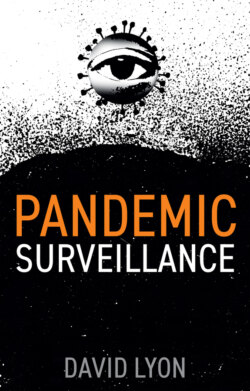Pandemic Surveillance

Реклама. ООО «ЛитРес», ИНН: 7719571260.
Оглавление
David Lyon. Pandemic Surveillance
Table of Contents
List of Illustrations
Guide
Pages
Pandemic Surveillance
Copyright Page
Dedication
Acknowledgments
1 Defining Moments
What is “pandemic surveillance?”
Context is critical
Pandemic and tech-solutionism
The burden of this book
Road-map to Pandemic Surveillance
Notes
2 Disease-Driven Surveillance
Contact tracing and location-tracking apps
Contrasting contact tracing systems
Centralized contact tracing
Decentralized contact tracing
Problems with platforms
Beyond contact tracing
Public health information systems
Surveillance surge
Notes
3 Domestic Targets
Work “place” monitoring
School-at-home monitoring
Online shopping from home
Where from here?
Notes
4 Data Sees All?
A cautionary tale about data-handling
Dubious assumptions about data
Data makes people visible
Data represents people in particular ways
Data helps to determine how people are treated
Notes
5 Disadvantage and the Triage
Pandemic disadvantage and healthcare surveillance
Surveillance and inequality in pandemic times
Notes
6 Democracy and Power
Hastily established initiatives
Surveillance capitalism, pandemic power
Civil liberties, human rights and privacy at risk
Emerging issues
No sunset for pandemic projects?
Notes
7 Doorway to Hope
A tale of two countries
Beyond apocalypse
Pandemic as portal
Notes
Index
POLITY END USER LICENSE AGREEMENT
Отрывок из книги
David Lyon
In the same month, news media started commenting on the sudden burgeoning of surveillance. Its main feature at that time was the rollout of the first digital contact tracing systems, using smartphones to identify contacts who may have been exposed to the virus. By April, tech giants Google and Apple had joined forces to support Bluetooth-based apps, a signal that platforms and governments were collaborating in such surveillance. Cautions about “false positives” and the need for accompanying testing and treatment facilities, plus fears regarding privacy intrusion, discrimination and marginalization were downplayed by those confident in the capacities of the silver bullet.
.....
However, it is not enough just to discuss those digital technologies as they are applied to formal systems of surveillance, where all the emphasis is on how those systems bear down on “us,” the objects of surveillance. This is because we, those surveillance objects, are also subjects of surveillance. While the apps, the cameras, the wearables “watch” us, we also glance slyly at each other – checking for masks, for 2-meter distance on sidewalks, for signs that neighbors are meeting with others beyond family. Moreover, the way we are classified – “no symptoms,” “has received vaccine,” “was exposed to a carrier” – may affect the way we see ourselves and watch, assess, interact with others, including how we measure our relationships with them. This is because today we develop new cultures of surveillance,13 such that there’s a “looping effect”14 between the classifications and the people classified. Those classified not only classify others, but may modify their own activities due to their surveillance classification.
Almost all the proposed ways of dealing with the pandemic address only the symptoms, not the causes. They are Band-Aids, intended to contain and control the virus. At the time of writing, the original causes are not known to science, so the Band-Aid approach is understandable. Knowledge gleaned from many historical epidemics and pandemics informs how public health officials respond when new outbreaks occur. It is doubtful how much could be learned – except perhaps negatively – from the fourteenth-century Black Death, which killed huge swathes of the population around the Mediterranean. A wide variety of sometimes exotic treatments were proposed, from herbalism to blood-letting to self-flagellation, although doctors did learn to lance the bodily buboes that gave the disease its other name, “Bubonic Plague.”
.....